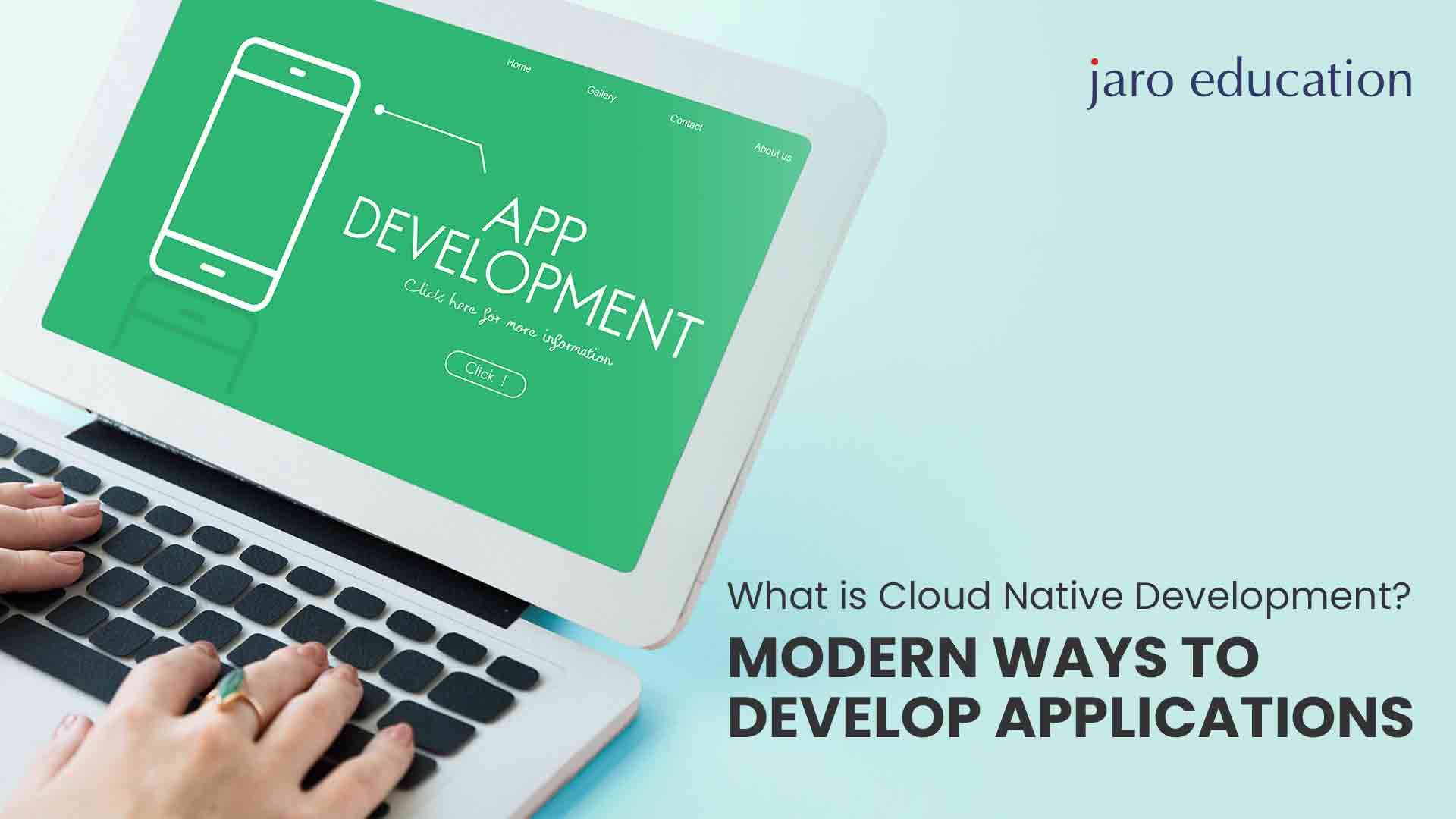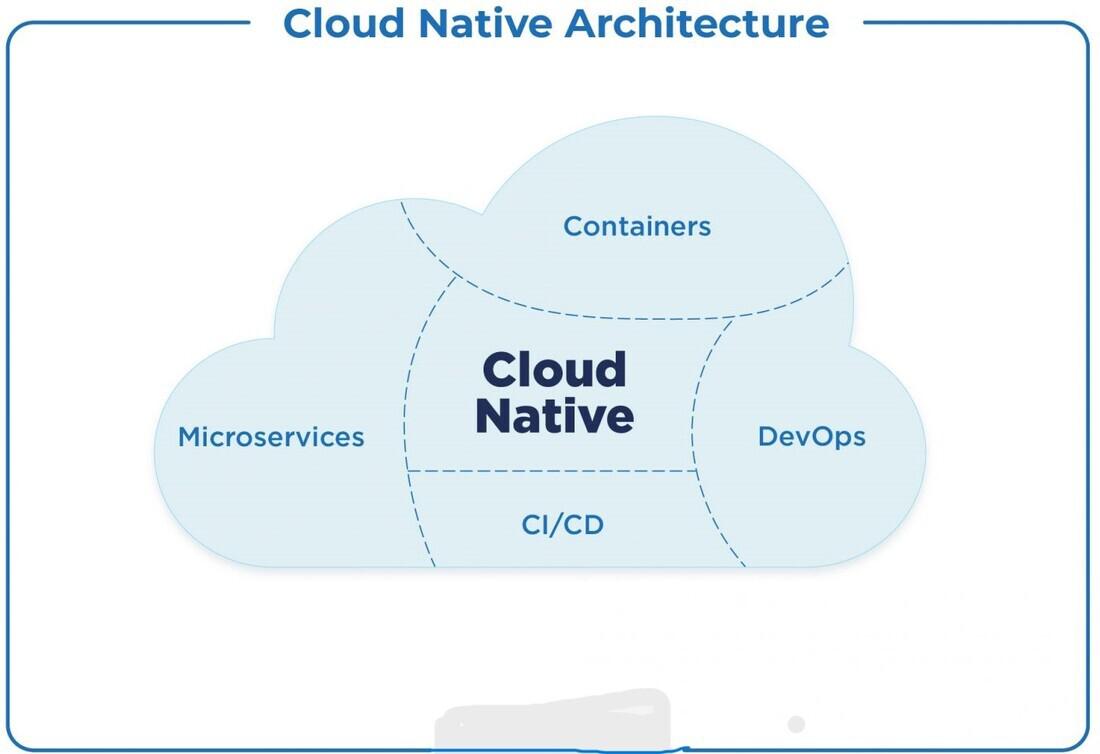Cloud Native Development: Modern Ways To Develop Applications
Table of Contents

- jaro education
- 8, April 2024
- 2:00 pm
Cloud-native development is a modern approach to creating and managing applications using tools from cloud computing. It’s not just about technology; it involves changing how teams work together and adopting new ways of building software. The goal is to make it easier to handle complex tasks and speed up the development of software.
When organizations use cloud-native development, they can quickly bring new ideas to the market and respond faster to customers’ needs. This method relies on technologies like containers and Kubernetes, which help build and run applications efficiently. Cloud-native development includes important practices like DevOps, continuous integration, and continuous delivery (CI/CD). It embraces modern application design methods, such as microservices and serverless architecture.
Whether an application is deployed on-premises, in the public cloud, or in a mix of different environments, the focus is on having flexible computing power and access to the latest tools for data and applications. This flexibility ensures success in the ever-evolving world of modern development.
What are Cloud Native Applications?
Cloud-native applications epitomize a revolutionary shift in software development, employing the orchestration of microservices—compact, interdependent modules that collectively form a cohesive application. Departing from traditional monolithic structures, cloud-native applications embrace microservices, fostering agility and resource efficiency.
In contrast to conventional enterprise applications, constrained by inflexible development methods and delayed deployment, cloud-native counterparts champion collaboration and scalability. Developers leverage advanced automation tools for streamlined creation, testing, and deployment, enabling the instantaneous setup, deployment, and replication of microservices—an unprecedented feat in the traditional application arena. This transformative approach positions cloud-native applications as dynamic, scalable, and technologically sophisticated solutions, reshaping the terrain of modern software development.
For individuals looking to navigate this cutting-edge field, the “Executive Programme in Full Stack Web Development” offered by the IITM Pravartak Technology Innovation Hub of IIT Madras provides an excellent opportunity. This course equips participants with the skills needed to excel in creating cloud-native applications, leveraging the latest in web development practices and technologies.

*Geeksforgeeks
Modern Ways To Develop Applications
Modern application development, Cloud Native Development stands as a powerful force, harnessing the capabilities of cloud computing methodologies and advanced tools. This transformative approach revolves around the strategic structuring of teams, nurturing a specific culture, and harnessing technology to leverage the potential of contemporary architectures, including microservices and serverless computing. This paradigm shift signifies a departure from traditional development methods, paving the way for enhanced flexibility, scalability, and agility in meeting the demands of the digital era.
Key Principles of Cloud Native Development
Microservices Architecture
Cloud Native Development embraces a microservices architecture, breaking down applications into smaller, independent services. This modular approach enhances flexibility, scalability, and resource efficiency.
Serverless Computing
The adoption of serverless computing allows developers to focus on writing code without the burden of managing infrastructure. This paradigm shift enables more efficient resource utilization and cost-effectiveness.
Cultural Transformation
Beyond technology, Cloud Native Development entails a cultural shift within organizations. It encourages collaboration, innovation, and an iterative mindset, aligning teams with the dynamic nature of modern software development.
Continuous Integration/Continuous Delivery (CI/CD)
Automated CI/CD pipelines play a crucial role in Cloud Native Development, ensuring rapid and reliable software releases. This accelerates the development lifecycle, fostering agility and responsiveness.
Containerization
Containers, encapsulating application code and dependencies, are a fundamental aspect of Cloud Native Development. Technologies like Docker facilitate consistent and scalable deployment across diverse environments.
The Impacts and Advantages
Enhanced Agility
Cloud Native Development enables organizations to respond swiftly to changing requirements and market dynamics, fostering a culture of continuous improvement.
Optimized Resource Utilization
The modular and scalable nature of microservices and serverless computing optimizes resource allocation, leading to cost savings and improved operational efficiency.
Innovation and Collaboration
By fostering a culture of innovation and collaboration, Cloud Native Development empowers teams to explore new ideas, experiment with technologies, and drive continuous evolution.
Scalability and Resilience
The inherent scalability of microservices and serverless architectures, coupled with automated CI/CD practices, ensures applications are resilient, adaptable, and well-suited for dynamic workloads.
Cloud Native Development marks a paradigm shift in how applications are conceived, designed, and deployed. It goes beyond a technological upgrade, embodying a holistic approach that encompasses technology, culture, and methodology. This transformative force is reshaping the modern application development process, propelling organizations towards greater innovation, efficiency, and responsiveness to the ever-evolving digital landscape.
Advantages of Cloud Native Development
Embracing Cloud Native Development comes with a myriad of advantages, propelling organizations into a realm of enhanced efficiency, agility, and innovation. Here are key benefits that underscore the significance of adopting Cloud Native Development:
1. Agility and Speed
Rapid Deployment
Cloud Native applications leverage automation and containerization, allowing for quick and efficient deployment of new features and updates.
Faster Time-to-Market
Microservices architecture enables independent development and deployment, accelerating the overall time-to-market for applications.
2. Scalability and Resource Optimization
Efficient Resource Utilization
Microservices and serverless computing models enable precise resource allocation, optimizing usage and minimizing wastage.
Dynamic Scalability
Cloud Native applications effortlessly scale up or down based on demand, ensuring optimal performance during varying workloads.
3. Reliability and Resilience
High Availability
The modular nature of microservices enhances system resilience. If one service fails, others continue to function, ensuring high availability.
Automated Recovery
Cloud Native applications often include automated recovery mechanisms, minimizing downtime and enhancing overall reliability.
4. Cost Efficiency
Pay-as-You-Go Model
Serverless computing follows a pay-as-you-go pricing model, allowing organizations to pay only for the computing resources consumed, leading to cost savings.
Optimized Infrastructure Costs
Efficient resource allocation and scaling contribute to reduced infrastructure costs, making Cloud Native Development a cost-effective approach.
5. Innovation and Experimentation
Encourages Experimentation
The culture of Cloud Native Development promotes experimentation with new technologies, fostering a dynamic environment for innovation.
Continuous Improvement
Teams can iterate rapidly, experiment with features, and continuously improve applications based on real-time feedback.
6. Collaborative Culture
Cross-Functional Collaboration
Cloud Native Development encourages collaboration between development, operations, and other cross-functional teams, fostering a unified and collaborative work culture.
DevOps Integration
Integrating DevOps practices ensures seamless collaboration between development and operations teams, enhancing overall efficiency.
7. Security and Compliance
Granular Security Controls
Microservices architecture allows for more granular security controls, reducing the impact of security breaches.
Compliance Measures
Cloud providers often offer compliance certifications, ensuring that Cloud Native applications adhere to industry-specific regulatory standards.
8. Adaptability to Change
Easier Adaptation
Cloud Native applications are designed to adapt to changes in requirements, technologies, and market conditions, ensuring sustained relevance.
Flexibility in Technology Stacks
Cloud Native Development allows flexibility in choosing technologies, facilitating the incorporation of the latest tools and frameworks.
9. Global Reach
Distributed Architecture
Cloud Native applications can be deployed globally, ensuring low-latency access for users across different geographic locations.
Edge Computing Integration
Cloud Native Development seamlessly integrates with edge computing, extending the reach of applications to the edge of the network.
Best Practices for Cloud-Native Application Development
Crafting effective practices for cloud-native application development involves aligning with the DevOps principle of operational excellence. Although there are no strict guidelines for cloud-native architecture, businesses tailor their development strategies based on the specific challenges they aim to address and the software they utilize.
Within the domain of cloud-native application design, the following five essential components serve as guiding principles:
1. Automate
Automation stands as a cornerstone in cloud-native application development, offering a strategic advantage in ensuring the uniform provisioning of cloud application environments across diverse cloud vendors. By prioritizing automation, organizations streamline the deployment and management of their applications, promoting efficiency and consistency.
One key approach to implementing automation is through the use of Infrastructure as Code (IaC). This method involves encoding the infrastructure setup, configuration, and policies into machine-readable scripts. In the context of cloud-native development, IaC enables developers to systematically track changes in the infrastructure by maintaining a comprehensive record within a centralized source code repository.
Through Infrastructure as Code, changes to the cloud environment become traceable and manageable, facilitating collaboration among development teams. This not only enhances version control but also provides a robust foundation for continuous integration and deployment processes. The systematic use of automation and IaC contributes to a more agile and reliable development lifecycle, reducing the potential for errors and ensuring the scalability of cloud-native applications across different cloud providers.
2. Monitor
The cloud-native application development, the facet of monitoring assumes paramount importance. It entails the implementation of robust practices that span both the development environment and the operational life of the application. A comprehensive monitoring approach transcends mere performance tracking.
It involves establishing seamless capabilities that cover every aspect, from the underlying supporting infrastructure to the intricate functionalities of the application itself. This holistic monitoring strategy equips developers and operational teams with real-time insights into the health and behavior of the application. Within the context of cloud-native development, monitoring goes beyond surface-level metrics, delving deep into resource utilization, system performance, and the overall efficiency of the application.
The insights garnered through effective monitoring enable organizations to proactively identify potential issues, track the utilization of resources, and maintain a proactive stance in addressing emerging challenges. A well-structured monitoring framework contributes to enhanced operational visibility, empowering development teams to make informed decisions and continually optimize the performance and reliability of their cloud-native applications. This proactive approach ensures the seamless functioning of applications and bolsters the overall health of the cloud-native ecosystem.
3. Document
In the context of cloud-native application development, meticulous documentation emerges as a cornerstone practice. Recognizing the collaborative nature of building cloud-native apps, which often involves multiple teams, thorough documentation becomes imperative.
Documentation serves as a vital tool in this collaborative landscape, offering a comprehensive record of changes and insights into the unique contributions of each team to the overall application. It plays a crucial role in fostering transparency, ensuring that all stakeholders, from developers to operational teams, have a clear understanding of the evolving landscape of the cloud-native application.
A well-documented approach encompasses various dimensions, including architectural decisions, development workflows, and integration points between different microservices. This detailed documentation not only serves as a historical reference but also aids in knowledge sharing, enabling teams to navigate the intricate details of the application’s evolution.
By prioritizing documentation in cloud-native development, organizations promote effective communication, streamline collaboration, and lay the groundwork for a more resilient and sustainable development lifecycle. In essence, documentation becomes a key enabler in navigating the complexities of cloud-native application development with clarity and coherence.
4. Make Incremental Changes
In cloud-native application development, championing the philosophy of incremental changes stands as a fundamental best practice. Encouraging incremental and reversible alterations to both the application and its underlying architecture is key to fostering a dynamic and adaptive development environment.
By prioritizing incremental changes, development teams embrace a methodology that allows for continuous learning and adaptation. This approach, facilitated by infrastructure as code (IaC) and robust change tracking in a dedicated source repository, empowers developers to experiment, learn from adjustments, and avoid permanent mistakes.
The essence of making incremental changes lies in the ability to iterate rapidly, ensuring that each modification contributes positively to the application’s functionality and overall architecture. This iterative process, supported by IaC, not only enhances agility but also minimizes the risk of introducing irreversible errors.
In summary, advocating for incremental changes is a strategic approach that aligns with the dynamic nature of cloud-native development, providing developers with the flexibility to evolve the application iteratively while maintaining the ability to roll back changes if needed.
5. Design for Failure
In the context of cloud-native application development, the crucial principle of “Design for Failure” emphasizes proactive strategies to navigate inevitable challenges in the cloud environment. This approach involves creating processes that anticipate and handle failures effectively.
At its core, “Design for Failure” advocates for the implementation of robust test frameworks capable of simulating diverse failure scenarios. These frameworks serve as proactive tools, empowering development teams to intentionally introduce failures and observe the application’s responses. Through deliberate experimentation, teams gain valuable insights into potential vulnerabilities and areas for improvement.
The primary goal is not to evade failure entirely but to embrace it as an integral aspect of the cloud landscape. By intentionally designing processes to accommodate failures and implementing measures to bolster resilience, cloud-native applications become more adept at handling unforeseen challenges. This iterative approach to simulating and analyzing failures fosters a culture of continuous improvement, ensuring that the application evolves to manage disruptions effectively.
Challenges of Cloud-Native Application Development
Embracing cloud-native application development introduces a set of challenges that impact developers, operations teams, and entire organizations. These challenges encompass various aspects:
- Software Version Coordination: Coordinating diverse software versions across different cloud providers becomes a significant challenge. Ensuring seamless compatibility and integration becomes paramount in this dynamic environment.
- Dynamic Scaling Complexity: The imperative to rapidly scale applications, both up and down, introduces complexity. Efficiently managing fluctuating workloads requires dynamic scalability measures to maintain optimal performance.
- Growing System Complexity: The addition of more services and components contributes to the overall intricacy of the system. Effectively managing this complexity is essential to uphold a streamlined and functional application architecture.
- Challenges of Ephemeral Infrastructure: The transient nature of ephemeral infrastructure complicates debugging and troubleshooting processes. Rapid changes in infrastructure components demand robust strategies for identifying and promptly resolving issues.
- Optimizing Resource Utilization: Efficiently utilizing cloud resources is paramount, given the cost implications of the pay-as-you-go model. Striking a balance between resource usage and application performance is essential for cost-effectiveness.
- Interoperability Concerns: Ensuring seamless collaboration among various components presents a critical challenge. All components must work cohesively to deliver a unified and efficient cloud-native application.
Effectively addressing these challenges involves leveraging powerful tools such as Kubernetes, Docker containers, and Terraform. Automation plays a pivotal role in deploying, managing configurations, and provisioning infrastructure. Organizations must remain vigilant, proactively tailoring strategies and solutions to optimize their cloud-native development journey.
Examples of Cloud-Native Applications
Cloud-native applications are designed to take full advantage of cloud computing environments, utilizing microservices architecture, containers, and other cloud-native technologies. Here are some examples of cloud-native applications:
- Netflix: Netflix is a prime example of a cloud-native application. It utilizes microservices to deliver its streaming services efficiently. The use of containers and cloud-native infrastructure allows Netflix to scale its services dynamically based on user demand.
- Spotify: Spotify, the popular music streaming service, leverages cloud-native principles for its platform. By employing microservices and containerization, Spotify ensures agility and scalability, providing users with a seamless and responsive music streaming experience.
- Uber: Uber’s ride-sharing platform is built on cloud-native principles. The application uses microservices to manage various aspects such as ride matching, pricing, and driver coordination. This architecture enables Uber to scale rapidly and adapt to changing demands.
These examples showcase how cloud-native applications can span various industries, providing scalable, agile, and reliable services to users worldwide. These instances across different sectors underscore the transformative impact and versatility of cloud-native applications in delivering services that are both resilient and user-centric on a global scale.
For individuals keen on mastering the intricacies of cloud-native applications and full-stack web development, the Executive Programme in Full Stack Web Development by the IITM Pravartak Technology Innovation Hub at IIT Madras offers an exceptional pathway. This meticulously designed program aims to arm participants with the latest skills and insights required to excel in the development of cloud-native applications, laying a solid groundwork for innovation and leadership in the fast-paced digital arena.
Conclusion
Cloud Native Development transcends geographical boundaries and traditional deployment constraints. It is a transformative force that empowers developers to craft applications with unparalleled agility and scalability. By embracing Cloud Native Development, organizations position themselves at the forefront of the modern application development landscape, ready to navigate the complexities of the digital era.
Cloud-native development signifies a transformative approach to application creation and management, leveraging cloud computing methodologies and cutting-edge tools. Focused on agility and efficiency, it embraces microservices, serverless computing, and cultural shifts for innovation. Incorporating automated CI/CD practices, containerization, and an emphasis on incremental changes, it accelerates development while addressing challenges like software version coordination. Examples such as Netflix, Spotify, and Uber illustrate the success of cloud-native applications, demonstrating their adaptability to diverse industries. This paradigm shift ensures organizations remain responsive to evolving market dynamics, fostering continuous improvement and efficiency in the digital era.









